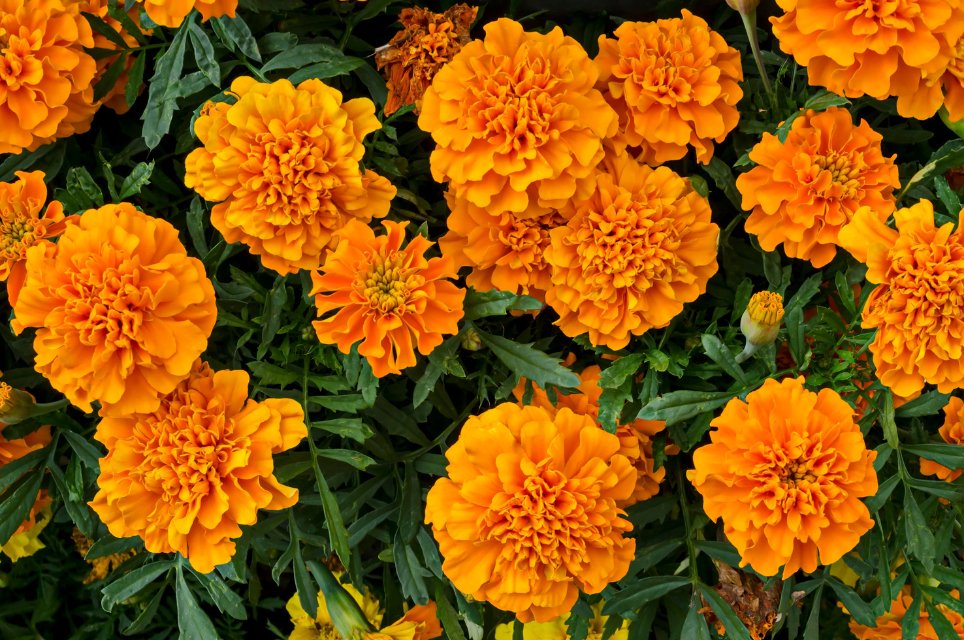
How to Grow & Care Marigolds (Genda Phool) for Festive Blooms: A Complete Guide
Introduction
Marigolds are among the most beloved and versatile flowers in Indian gardens, especially during the festive season. Known for their vibrant colors, they are the go-to flowers for decorating homes and creating a festive atmosphere, whether it's Diwali, Navratri, or any celebration. Marigolds come in a stunning range of colors, including yellow, orange, white, red, gold, and bi-color, adding a delightful mix to your garden.

Beyond their decorative appeal, marigolds are also valued for their pest-repellent properties and low-maintenance care. Whether you’re a seasoned gardener or just getting started, marigolds make a fantastic addition to any garden.
In this guide, we’ll cover everything you need to know about growing marigolds at home, from choosing the right varieties to caring for them throughout the festive season. Best of all, you can use Lazy Gardener’s tools and fertilizers, like BloomStix and Bloom Spray, to ensure the healthiest blooms possible.
Types of Marigolds Common in India
-
French Marigold (Tagetes patula): Known for their compact size and bushy growth, French marigolds come in vibrant shades of yellow, orange, and red. They're perfect for borders and container gardens, thriving in almost all soil types.

-
African Marigold (Tagetes erecta): Also known as the big bloomers, African marigolds produce large, ball-shaped flowers in rich hues of yellow and orange. These taller varieties are ideal for flower beds and larger garden spaces.

-
Mexican Marigold (Tagetes lucida): This unique variety has aromatic leaves and golden-yellow flowers, often used in traditional rituals and decorations. Mexican marigolds are valued for their adaptability and drought tolerance.

Each of these marigold varieties brings something special to your garden, making them a perfect choice for adding color and fragrance during the festive season!
Step-by-Step Guide to Growing Marigolds
1. Choosing the Right Location
Marigolds thrive in full sun. Choose a spot in your garden or balcony that gets at least 6-8 hours of sunlight. If you’re growing them in containers, ensure they are placed in a sunny location.
Pro Tip: In case of partial shade, they may still bloom, but not as profusely.
2. Preparing the Soil
Marigolds prefer well-drained soil with a slightly sandy texture. They are not fussy about soil quality but do best in soil enriched with organic matter. Ensure that the soil doesn’t retain too much water, as this can lead to root rot.
Pro Tip: Use BloomStix to enrich the soil with essential nutrients for stronger roots and better blooms.
3. Sowing the Seeds or Transplanting Seedlings
You can either sow marigold seeds directly into the soil or transplant young marigold seedlings. If planting seeds, space them about 8-12 inches apart, depending on the variety.
Pro Tip: To accelerate growth, spray your marigold seedlings with Bloom Spray every 7-10 days. It provides essential nutrients for lush, vibrant blooms.
4. Watering
Marigolds are relatively drought-tolerant but need regular watering during their early growth stage. Water the plants when the top inch of soil feels dry, ensuring the soil remains moist but not waterlogged.
Pro Tip: For container plants, use plant stands to avoid waterlogging, especially during the monsoon.
5. Fertilizing
Marigolds are light feeders, but for optimum blooms, fertilize the plants with a balanced, slow-release fertilizer every 3-4 weeks. Our BloomStix are designed to release nutrients gradually, promoting healthy growth and vibrant blooms.
6. Deadheading for More Blooms
To encourage continuous blooming, remove the spent flowers (deadheading). This allows the plant to direct its energy into producing more flowers instead of seeds.
Pro Tip: Use Lazy Gardener’s Anvil Cutters for precise pruning and deadheading without damaging the plant.
Caring for Marigolds During the Festive Season
As marigolds mature, they become resilient and require minimal care. However, here are a few tips to ensure they stay healthy through the festive season:
- Pest Control: Marigolds are natural insect repellents, but aphids can sometimes attack. Use organic neem oil spray to keep pests at bay.
- Pruning: Regularly prune excess foliage to allow better airflow around the plants, reducing the chance of fungal infections during humid weather.
- Water Management: Be cautious not to overwater marigolds during the rainy season. Ensure pots have adequate drainage by using plant stands.
6 Colors for Your Festive Garden
- Yellow Marigold: Symbolizing positivity and happiness, yellow marigolds are perfect for brightening any space.
- Orange Marigold: The vibrant orange hue is a crowd favorite during Diwali and other festivals.
- White Marigold: Elegant and unique, white marigolds add a touch of serenity to your garden.
- Red Marigold: These bold blooms are ideal for creating striking color contrasts in festive decor.
- Gold Marigold: Golden marigolds symbolize prosperity and abundance, a must-have for any festive garden.
- Bi-Color Marigold: With multiple colors in one bloom, bi-color marigolds add a dramatic flair to your garden displays.
Conclusion
Growing marigolds is a simple yet rewarding experience, especially during the festive season when their vibrant blooms brighten homes and celebrations. With minimal care, regular fertilization using BloomStix, and the occasional boost from Bloom Spray, you can enjoy healthy, abundant blooms that last throughout the season.
Get started on your marigold-growing journey today with the help of Lazy Gardener's premium gardening products and turn your garden into a festive paradise!
Happy Gardening!
The Lazy Gardener Team



Leave a comment